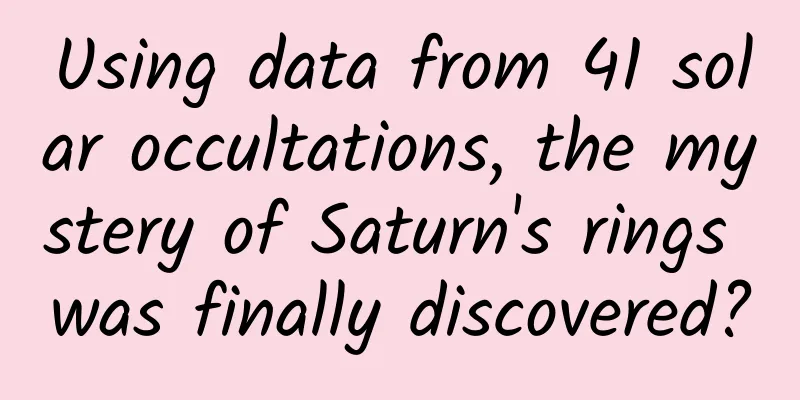Using data from 41 solar occultations, the mystery of Saturn's rings was finally discovered?

|
Sun reveals secrets of Saturn's rings Saturn's rings as seen from NASA's Cassini spacecraft. A new study uses Cassini data to probe secrets of Saturn's rings, including the size and composition of ring particles. Image via NASA/ JPL-Caltech/ SSI/ Cornell/ SwRI. Are Saturn's rings young relative to the rest of the solar system? Were they formed by the destruction of icy moons or comets? Are they a permanent feature of Saturn? Or will they one day cease to exist? On October 18, 2022, astronomers announced a new study that helped them probe the secrets of Saturn's rings. The astronomers used data from 41 solar occultations -- events in which Saturn's rings were seen passing in front of the sun -- from NASA's Cassini spacecraft, which orbited Saturn from 2004 to 2017. These observations not only provide clues to the size distribution and composition of the rings, but also allow astronomers to deepen their understanding of how the rings formed and their ultimate fate. Researchers from the Southwest Research Institute, the University of Central Florida and the University of Colorado Boulder published their peer-reviewed findings in the December 2022 issue of the journal Ikaros (Volume 388). The Secret of Saturn's Rings Scientists want to better understand the origins of Saturn's ring system. For example, how old are the rings? How did they form? Stephanie Jammack, lead author of the new study from the Southwest Research Institute, said: For nearly 20 years, NASA's Cassini spacecraft has shared the wonders of Saturn and its family of icy moons and iconic rings, but we still don't know the origin of the ring system. Evidence suggests that the rings are relatively young and may have formed from the disruption of an icy moon or comet. However, to make sense of any origin theory, we need a good understanding of the size of the particles that make up the rings. Solar occultation helps reveal secrets of Saturn's rings To conduct the new study, astronomers used data from Cassini's Ultraviolet Imaging Spectrograph (Ultraviolet Imaging Spectrograph). Previously, while Cassini was still orbiting Saturn, the UIS observed the rings at the same time as it observed the Sun. Because the instrument was observing through the rings, particles partially blocked light from the Sun. This is called a solar occultation. The UIS could then measure the optical depth of these particles. How do they know? Generally speaking, these particles absorb and scatter light from the sun. The amount of light blocked tells scientists the optical depth of the particles. These data provide clues to the size and composition of these particles. Jarmark said: "These observations give us an idea of the smallest particle size in Saturn's rings, given the wavelength of light coming from the Sun. The UVI Spectrometer can detect dust particles at the micrometer level, helping us understand the origin, collisional activity, and disruption of ring particles within the system." Clues to planet formation By observing the sun's light passing through the rings at different angles, the researchers can also learn more about the overall structure of the ring system. Furthermore, these findings can also be applied to the formation of planets in general. As Jarmak explains: Ring systems around giant planets also provide testbeds for studying fundamental physical properties and processes in our solar system. These particles are thought to be caused by objects colliding in the disk and forming larger particles. Understanding how they form these ring systems could also help us understand how planets form. Here we see Saturn's rings backlit by the Sun. Cassini captured this iconic image on July 19, 2013. Cassini was looking through the rings at the Sun, and particles in the rings created the occultation. Image via NASA/ JPL-Caltech/ SSI. Saturn's lost moon Chrysalis Last month, scientists at the University of California, Berkeley, said Saturn's rings may have formed when Chrysalis, a former moon about the size of Iapetus, broke apart after passing too close to Saturn. Eventually, whatever was left of Chrysalis that didn't fall into Saturn's own atmosphere became the rings. In addition, computer simulations show that Saturn's largest moon, Titan, disrupted Chrysalis' orbit, causing it to pass too close to Saturn. A 2019 study suggests that Saturn's rings may be less than 100 million years old. While Saturn may be the jewel of the solar system now, it wasn't always this way! Finally, a new study uses solar occultation data from NASA's Cassini mission to better understand the composition, formation, and other secrets of Saturn's rings. BY:Paul Scott Anderson FY: Knowing the Moon in a Dream If there is any infringement of related content, please contact the author to delete it after the work is published. Please obtain authorization for reprinting, and pay attention to maintaining integrity and indicating the source |
<<: He searched the Pan-Himalayan region to find the grass for the lamb chops.
>>: Don’t ignore a minor cold, beware of “viral myocarditis”!
Recommend
Who is abandoning Sacon kitchen appliances? Sunrise in the East is not the savior
For Sunrise East, which is eager to get out of th...
How to build a community from 0 to 1?
Communities are usually divided into two dimensio...
In ancient times when technology was not well developed, how did silver bills prevent counterfeiting?
As we all know, although the silver note is just ...
Analysis of common problems in bidding promotion!
In bidding promotion , we often encounter some co...
Eating barbecue and being sent to the ICU! What is Guillain-Barré syndrome?
Review expert: Wang Xuejiang, professor of pathop...
iOS 15 official version is approaching: Apple expands the scope of Beta testing
The official version of iOS 15 is getting closer ...
China Association of Automobile Manufacturers: Economic Operation of the Automobile Industry in October 2024
In October 2024, my country's automobile prod...
A practical guide to high conversion rates with KOL campaigns!
In the era of traffic anxiety, companies are incr...
Marketing Planning Triangle Law!
Predicting the launch of new products is like for...
Internet + door-to-door service: How to play in this market with strong demand?
Penguin Intelligence | Research and Production Re...
iOS Programming Basics: How does the Hello World App work?
Translator’s Note: 1. Since this is a technical a...
WeChat teaches you how to set up a street stall: This score is your signboard
It seemed as if overnight, setting up stalls beca...
A comprehensive review of the hottest marketing rule in 2018: “social fission”!
If you were to find a keyword for the marketing f...
Analysis of advertising in the home furnishing industry!
As people's living standards improve, obtaini...
Summer "high-end meal": beer + seafood? Learn more about gout →
In the hot summer, beer and seafood seem to have ...









